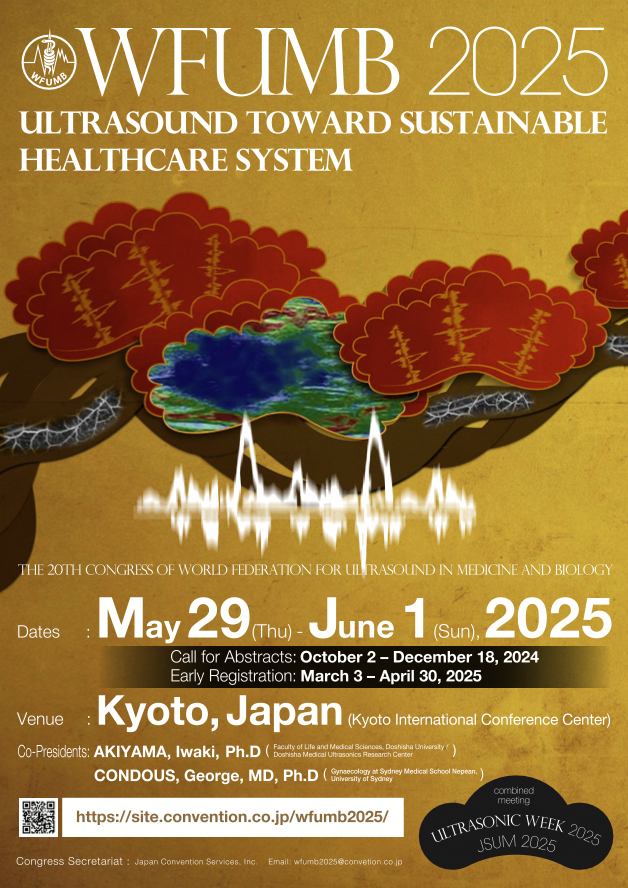Original Works and Case Reports from the below topics will be accepted.
Extended to January 13, 2025, 23:59 JST.
Symposium
Submission for Symposium has been closed.
Gastrointestinal and Hepato-Biliary-Pancreatic Ultrasound
Elastography for portal hypertension: current status and future perspective
Objective
Elastography is applied to assess the risk and severity of various coexisting conditions in portal hypertension and predict prognosis of the patients as well as to determine the degree of hepatic fibrosis. It is used throughout the medical care process for portal hypertension, from diagnosis, understanding the pathophysiology, and to the treatment, acting as a main axis. In this session, we would like to demonstrate the practical use of elastography and clarify its specific usefulness, problems, and challenges. We would also like to deepen our understanding of the role and significance of elastography in the management of portal hypertension and discuss prospects.
Transdisciplinary Ultrasound
Artefacts in ultrasound
Objective
Ultrasonography (US) is the primary diagnostic tool for the whole abdomen. A solid understanding of the basic physics of US technology is essential to enhance diagnostic accuracy and avoid misinterpretation of images. Modern US diagnosis includes not just traditional B-mode and Doppler US, but also contrast-enhanced US, elastography, and attenuation techniques. Rapid advancements in US technology mean that many practitioners conduct abdominal US exams without sufficient knowledge of US artifacts, despite their frequent occurrence in clinical settings. Most artifacts arise from the combination of two or three basic factors, and addressing these issues requires collaborative analysis of extensive clinical and basic data. Despite some progress over the past decade, our understanding of US artifacts remains incomplete. This session aims to discuss various topics related to US artifacts and foster shared interest among specialists from different fields. We invite questions and discussions from diverse perspectives and welcome explanations for challenging phenomena. If you attend, we encourage you to present an oral communication on US artifacts, including B-mode, Doppler, elastography, and contrast-enhanced US.
Artificial intelligence for ultrasound diagnosis
Objective
Artificial Intelligence (AI) has been developing rapidly and has become an indispensable part of medicine. Particularly in diagnostic imaging, AI has begun to make diagnoses that are as good as or better than those made by sonographers. In ultrasound imaging, the accuracy of diagnosis often depends on the experience and skills of the expert. However, even inexperienced sonographers can reach the same diagnoses as experts with the support of AI. Considering the current medical landscape, ultrasound plays a crucial role in primary care. In depopulated areas, a single physician must provide a variety of medical services. Ultrasonography is essential for such physicians because it is convenient and non-invasive. Even in regions lacking specialists, AI can deliver advanced medical care, comparable to that provided in more populated areas. In this session, expert researchers will report on the latest advancements in ultrasound diagnosis using AI and discuss its utility in daily medical practice.
Diagnosis with ultrasound elastography
Objective
Ultrasound-based elastography has advanced significantly and is widely used in clinical settings. In hepatology, it estimates liver fibrosis non-invasively, reducing biopsy needs. It aids in distinguishing benign from malignant lesions in breast and thyroid diagnostics and assesses tendon and muscle quality in orthopedics. Recent innovations allow evaluation of not only tissue “elasticity” but also “viscosity,” providing additional insights into tissue inflammation. This symposium will discuss the utility, innovations, and challenges of elastography across medical fields, providing a platform for experts to share knowledge and promote collaborative learning. Submissions are encouraged to foster knowledge exchange.
Sonographer
The future of ultrasound, what lies ahead
Objective
The session provide to anticipate and outline the trajectory of ultrasound technology. Experts discuss advancements, challenges, and potential breakthroughs that will shape the future of ultrasound. Key themes include artificial intelligence, 3/4 D US, expanding indication of CEUS and evolising US technology, all of which contribute to enhancing patient diagnosis and care.



